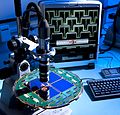Ficheiro:PIA17993-DetectorsForInfantUniverseStudies-20140317.jpg
Aparencia

Tamaño desta vista previa: 624 × 600 píxeles. Outras resolucións: 250 × 240 píxeles | 499 × 480 píxeles | 799 × 768 píxeles | 1.065 × 1.024 píxeles | 2.130 × 2.048 píxeles | 3.000 × 2.884 píxeles.
Ficheiro orixinal (3.000 × 2.884 píxeles; tamaño do ficheiro: 842 kB; tipo MIME: image/jpeg)
Historial do ficheiro
Prema nunha data/hora para ver o ficheiro tal e como estaba nese momento.
| Data/Hora | Miniatura | Dimensións | Usuario | Comentario | |
|---|---|---|---|---|---|
| actual | 17 de marzo de 2014 ás 21:13 |  | 3.000 × 2.884 (842 kB) | Drbogdan | User created page with UploadWizard |
Uso do ficheiro
A seguinte páxina usa este ficheiro:
Uso global do ficheiro
Os seguintes wikis empregan esta imaxe:
- Uso en an.wikipedia.org
- Uso en ar.wikipedia.org
- Uso en az.wikipedia.org
- Uso en de.wikipedia.org
- Uso en en.wikipedia.org
- Uso en fa.wikipedia.org
- Uso en fr.wikipedia.org
- Uso en he.wikipedia.org
- Uso en hy.wikipedia.org
- Uso en it.wikipedia.org
- Uso en ka.wikipedia.org
- Uso en ko.wikipedia.org
- Uso en mk.wikipedia.org
- Uso en nn.wikipedia.org
- Uso en pl.wikipedia.org
- Uso en pl.wikinews.org
- Uso en pt.wikipedia.org
- Uso en ru.wikipedia.org
- Uso en ru.wikinews.org
- Uso en sv.wikipedia.org
- Uso en uk.wikipedia.org
- Uso en www.wikidata.org
- Uso en zh.wikipedia.org


